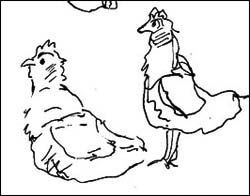 A study in the journal Environmental Health Perspectives found detectable levels of arsenic in chicken from grocery stores in 10 American cities, including in organic chickens. If the drug were fed to all chickens, over 100 US deaths would result from arsenic-related lung and bladder cancers, report the authors.
A study in the journal Environmental Health Perspectives found detectable levels of arsenic in chicken from grocery stores in 10 American cities, including in organic chickens. If the drug were fed to all chickens, over 100 US deaths would result from arsenic-related lung and bladder cancers, report the authors.
The National Chicken Council, which represents the firms that produce 95 percent of US meat chickens, dismissed the study as reflecting “very low levels of arsenic,” reported the New York Times.
This is not the first time arsenic levels in poultry have made the news. In 2011, Pfizer announced it would stop selling arsenic-treated chicken feed after the FDA found inorganic arsenic, a carcinogen, “at higher levels in the livers of chickens treated than in untreated chickens.” The FDA has approved arsenic in poultry feed for years to control parasites in birds, promote weight gain and feed efficiency and improve “pigmentation.” Like artificial dye in farmed salmon and gasses used to keep grocery store beef red, the FDA apparently puts public health risks below helping industry move its products.
In 2006 in the same journal, Environmental Health Perspectives, Dr. Ellen Silbergeld raised questions about arsenic levels in poultry including “additional exposures to arsenic from confined animal feeding operation (CAFO) wastes via land disposal, which may reach human populations though soil.” Such runoff from megafarms is now indicted for high levels of arsenic found in US rice. A Consumer Reports investigation last year found concerning arsenic levels in the food supply and recommended federal action.
At the time of the article, Dr. Silbergeld was assailed by Big Ag for raising the alarm about arsenic levels in poultry as having a “political agenda” but reports since 2011 suggest she was right.
The levels of arsenic reported recently in Environmental Health Perspectives are below federal limits and were also obtained before Pfizer withdrew its widely used feed product in 2011. But the researchers point out that the danger levels of arsenic for humans were established in the 1940s. Nor is the National Chicken Council a reassuring voice.
An article in the now discontinued Gourmet magazine says the National Chicken Council admits that 10 percent of chickens by the time they are hung from shackles at the slaughterhouse have had a wing dislocated, fractured, or broken from rough handling. It also admits that 2 percent of the birds are awake as the blade cuts their throat or boiled alive because they miss the stunner that is supposed to spare them. Richard L. Lobb, a spokesman for the Council said of the estimated 180 million a year who perish this way, “This process is over in a matter of minutes if not in seconds,” in Gourmet.
Both arsenic in birds and bird feed and the deaths described in Gourmet magazine stem from the cult of cheap food perpetrated by US factory farms. It is a cult food consumers are increasingly rejecting.
Martha Rosenberg is a freelance journalist and the author of the highly accalimed “Born With A Junk Food Deficiency: How Flaks, Quacks and Hacks Pimp The Public Health,” published by Prometheus Books. Check her new Facebook page.



Pingback: Document The Truth
Let’s put this in perspective. First, I’m not here to defend the NCC (only in America, right?), and it would be nice if you could eliminate 100% of arsenic in chicken (can you? I don’t know), but it’s ridiculous the way people are flipping out over this.
I once lived in an area in central California where the arsenic levels in the local well water are 100 times higher than allowed by the EPA, and you know what? NOBODY has ever died from arsenic poisoning in the entire valley, and it’s quite common for people there to live to 85-90 years. Arsenic occurs naturally in trace amounts in water, as well.